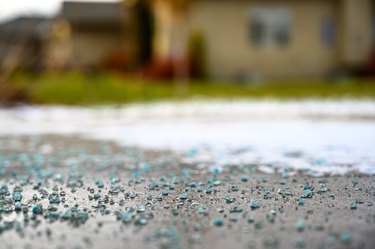
When winter approaches and snow and ice cover roads and sidewalks, people scramble to find ingredients that will make driving and walking easier. For years, salt compounds have been used to help people navigate these surfaces safely, but as far as which compound melts ice the fastest, the answer is a combination of chloride with sodium, calcium and magnesium, but it comes with caveats.
Fast-Melting Ice
Video of the Day
If your goal is to melt ice quickly around your home, then a combination of sodium chloride, calcium chloride pellets and magnesium chloride pellets, often known as ice melt, melts ice faster than plain rock salt, which is made with sodium chloride. However, ice melt doesn't create traction as quickly as rock salt.
Video of the Day
There are reasons people buy various types of salts to melt ice. Rock salt doesn't melt ice as quickly as ice melt, but it's cheaper at around $5 to $15 per 50-pound bag. Ice melt, on the other hand, costs about $13 to $25 for a 50-pound bag.
Although it may be cheaper to buy rock salt and you will create better traction more quickly, rock salt can be more corrosive to pavement or concrete. It can also be more corrosive to cars. Ice melt will melt the ice more quickly, but the traction won't be as good. It is also much less corrosive to cars and to asphalt. However, it can be highly corrosive to concrete.
How Does Salt Melt Ice?
Rock salt and ice melt both contain sodium chloride, which melts ice. This is because when water mixes with salt, water is less likely to form ice at 32 degrees, the temperature that water turns to ice.
Salt spread on ice doesn't melt ice by itself. It needs the friction of car tires or footsteps to turn the ice into a slush, and the salt mixture is less likely to refreeze at temperatures below freezing.
This is why melting ice by itself is often not the only strategy used when treating ice. The goal is for tires or boots to gain traction on ice, and rock salt and sand both do a good job of providing traction. Rock salt, however, can corrode your car and your sidewalk not to mention kill your plants and harm your pets. Sand doesn't cause ice to melt, but it provides traction and doesn't corrode hard surfaces, harm your pets or harm your plants.
Other Types of Salt Compounds
Most salt compounds will work to melt ice at temperatures to about 15 degrees. Once it gets colder than that, however, rock salt and magnesium chloride are less likely to melt ice, even with car or foot traffic. Calcium chloride does work much better in extreme cold, but this mixture can burn skin and harm pets.
An ice melt with a blend of magnesium chloride is typically the most expensive ice melt, but it tends to melt the fastest, is the least likely to harm your plants and lawn and is less corrosive to hard surfaces. It won't provide traction like rock salt does, but you can spread sand to provide traction.
There are also ice melt mixtures containing magnesium chloride that are pet-safe options. Some pet-safe options come in organic, salt-free compounds that will quickly melt ice. However, they don't provide traction, so consider spreading sand after you've treated the ice.